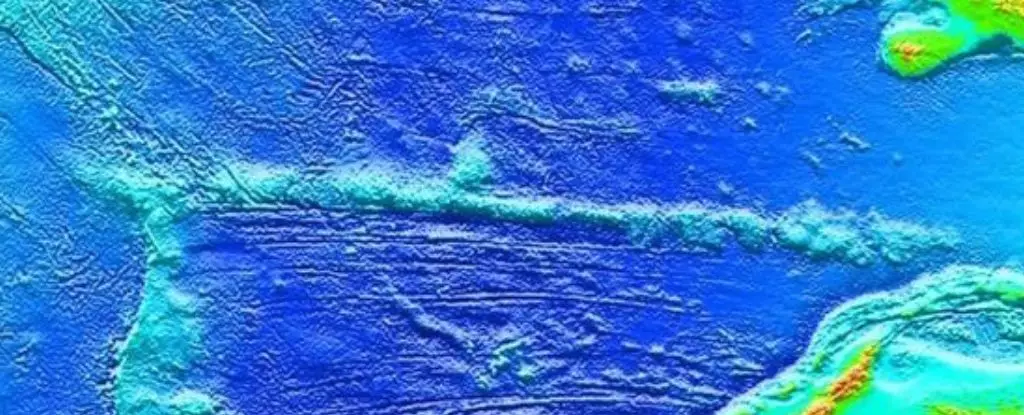While the world’s tallest mountain, Mount Everest, captures much of the attention in geological discussions, there exists a colossal mountain range hidden in plain sight beneath the Indian Ocean: the Ninetyeast Ridge. Stretching over 5,000 kilometers (3,107 miles), it surpasses even the vast North American Rockies. Yet, this underwater marvel remains largely overlooked and largely obscured by the ocean’s depths. Recent scientific investigations have peeled back some of the layers concealing this geological wonder, offering a fresh perspective on its origins, evolution, and significance in understanding tectonic dynamics.
At the heart of this underwater mountain system are seamounts—underwater volcanoes that shape various oceanic landscapes. Traditionally, these features have been illuminated by the “hotspot” theory, wherein intense heat from Earth’s mantle melts the rock, generating magma that ascends and leads to tremendous volcanic activity. Initially, scientists believed these hotspots remained fixed in place under the Earth’s surface, with tectonic plates gliding over them, leading to a continuous line of volcanic formations. This model likened the process to a sewing machine’s needle puncturing a moving fabric, creating a continuous seam.
However, the recent findings related to the Ninetyeast Ridge suggest a more complex narrative. The hotspot linked to the formation of this ridge showcases more dynamic behavior—akin to a fountain pen’s nib that moves across a sheet of paper while leaving a mark. A detailed study conducted by a team of international researchers has brought to light evidence that contradicts the conventional interpretation of hotspots remaining stationary.
At the heart of the Ninetyeast Ridge’s formation is the Kerguelen hotspot. This geological feature has sparked extensive debate among scientists regarding its historical movement and impact on continental drift. Previous studies presented ambiguous conclusions, indicating that the hotspot might have shifted position during its existence. A significant breakthrough came from a collaborative effort involving scientists from Australia, Sweden, China, and the US, who meticulously analyzed basalt samples extracted from the Ridge. Their findings not only corroborate earlier hypotheses but also suggest a dynamic nature to the hotspot, reinforcing the idea that it has traveled hundreds of kilometers within the Earth’s mantle over time.
As the Indian Plate drifted northward, consequently opening the Indian Ocean, the Kerguelen hotspot acted as a variable factor in shaping the seabed. The study revealed that, instead of remaining stationary, this hotspot’s influence was far more kinetic than previously assumed. It had an active role in establishing various geological features across the ocean floor.
By delving into the geology dating back between 83 and 66 million years ago, researchers discovered that the formation of the ridge’s peaks occurred at only half the speed of the surrounding seafloor spreading. Astoundingly, this indicates that the Kerguelen hotspot was not anchored beneath the Indian Plate, but rather, it moved autonomously, intermittently connecting with the spreading ridges. The scientific team posited that the plume of the hotspot had been caught in the motion of the northward-moving Indian-Antarctic ridge, with molten materials flowing toward the ridge to create eruptive geological features.
Such findings yield profound implications for our understanding of plate tectonics, suggesting that hotspot activity may not always be dictated by fixed locations beneath tectonic plates. Through this lens of fluid dynamics, the nature of hotspots can be seen as part of a greater narrative of interaction between Earth’s mantle and surface, leading to continuous transformation over eons.
The revelations surrounding the formation of the Ninetyeast Ridge provide crucial insights not only into the geodynamics of the Indian Ocean but also into the broader workings of our planet’s lithosphere. Understanding this underwater mountain range opens avenues for future research into how tectonic plates interact, shift, and reshape the Earth’s surface.
As more discoveries underpin the complexity and dynamism of hotspot phenomena, the scientific community may find this evidence further substantiating our understanding of volcanism, continental drift, and the geological history of our planet. The Ninetyeast Ridge serves as a testament to the enormity of Earth’s hidden geological treasures, and continued exploration beneath the ocean’s surface promises to unveil even more mysteries of our world.

Leave a Reply